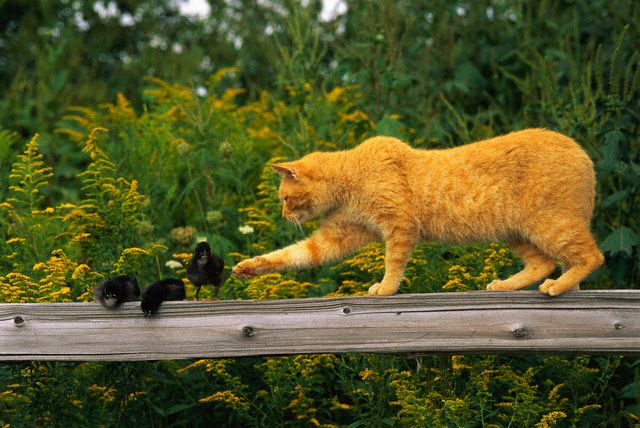
In his excellent book, Running With the Foxes, wildlife biologist David MacDonald writes that "foxhunting is of minor significance to foxes in particular, or amongst wildlife issues generally," and that almost any other environmental issue or impact is more important to fox welfare than foxhunting.
MacDonald also notes that there is nothing morally repugnant about fox hunting. He notes that "people's gastronomic enjoyment outweighs their concern for the consequences of harvesting billions of fish annually, as their enjoyment of their cat's companionship outweighs regret at the deaths of millions of hedgerow birds annually."
In their campaigns and protests, Animal Rights folks seem to overlook the domestic cat as a wildlife killing machine that does far more mayhem in the countryside than anyone hunting with dogs.
The article below come from the LaCrosse Tribune of August 15, 2004:
- - - - - - - - - - - - - -
One of Wisconsin's main predators can be regularly observed curled up on the front porch or strolling through the barn.
Studies have indicated free-roaming cats — from wandering household pets to skittish, semi-wild farm felines — are responsible for killing millions of birds and small mammals in the state each year.
"That's what cats do. They're a very efficient predator and you can't breed that out of them or make them stop doing it," said Dave Matheys, wildlife biologist for the Wisconsin Department of Natural Resources office in Viroqua, Wis.
In parts of south central Wisconsin, "cats are unquestionably the most abundant mammalian predator, outnumbering fox, skunks and raccoons combined," said Stanley Temple, a professor of wildlife ecology and environmental studies at the University of Wisconsin.
In 1996, Temple published results of a study on the effects of cat predation. Over five years, he and his team monitored free-ranging cats with the same methods as in other wildlife studies — tracking by radio collars, analysis of cat feces and stomach contents to determine what they ate — and came up with some disturbing figures.
Small mammals, such as young rabbits and rodents, accounted for about 70 percent of the cats' diet, Temple said. But the study concluded that, even at only 20 percent of their kills and the most conservative estimates for cat numbers and predation, at least 7.8 million birds were falling prey to felines in Wisconsin each year.
It's not feral cats, either, those that have reverted to living completely wild. In the five-year study, Temple said they never found a true feral cat — all maintained at least some regular contact with human-provided shelter and food — perhaps because of the state's harsh winters.
No, the majority of the felines stalking through the countryside are someone's barn cat or house pet, Temple said. Often they are fed and have some immunizations against disease, which gives them a competitive advantage over other predators.
Coyotes were thought to be a possible predator of cats, but Temple said his research didn't show significant losses to coyotes. Disease and vehicles were the main population controls on free-range cats.
The cats were not above going after other predators, either. Young snakes were a part of the diet, Temple said. And Matheys said he's had at least two reports, one this year, from cat owners whose pet brought home a dead weasel."Weasels are great predators," Matheys noted. "To have a cat kill them says something about the ability of cats."
Not surprisingly, grassland and ground-nesting birds were particularly hard-hit, Temple said. Cats were found to consume a number of young pheasant, even turkey chicks.
"We had all of Wisconsin's game birds show up in the diet," Temple said.
Which is why hunters and landowners sometimes will take matters into their own hands and shoot trespassing cats. But DNR officials warned it's illegal even for property owners to kill cats.
So what can be done? First and foremost, Temple said, is to convince people to keep their cats indoors. Measures such as declawing or placing a bell or other noisemaking collar had only limited success.
A life indoors not only keeps the cats away from wildlife, but also protects them from accidents, attacks by other animals and disease. Free-ranging cats often "lead short, miserable lives," Temple said.
Farmers should be encouraged to at least spay and neuter barnyard cats, so they are less likely to roam and won't continue to boost the roaming feline population. From his study, Temple recommended farms keep spayed females, as they had the smallest range and would be the most likely to hunt among the barns rather than the countryside.
But getting people to change their attitudes about cats is a major hurdle, DNR officials said. "So often people think, ‘I have a cat, it has to roam,'" said Thompson.
"It's kind of an accepted norm, that the cat goes out and does its thing. Dogs, too, to some extent in rural areas," Matheys said. "It's a slow process, to change human behavior and get people to restrain their dogs and cats.".
No comments:
Post a Comment